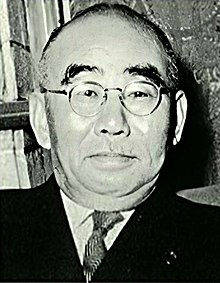Tanzan Ishibashi
Tanzan Ishibashi (石橋 湛山, Ishibashi Tanzan, 25 September 1884 – 25 April 1973) was a Japanese journalist and politician who was Prime Minister of Japan from 1956 to 1957. He was also Director General of the Japan Defense Agency in addition to being Prime Minister. During the same time he was the 2nd president of the Liberal Democratic Party, the majority party in the Diet. From 1952 to 1968 he was also the president of Rissho University. Being a member of Nichiren-shū, the name Tanzan is a religious name, as his profane name was Seizō (省三).
Tanzan Ishibashi | |
|---|---|
石橋 湛山 | |
 | |
| Prime Minister of Japan | |
| In office 23 December 1956 – 31 January 1957 | |
| Monarch | Shōwa |
| Preceded by | Ichirō Hatoyama |
| Succeeded by | Nobusuke Kishi |
| Director-General of the Japan Defense Agency | |
| In office 23 December 1956 – 31 January 1957 | |
| Monarch | Shōwa |
| Prime Minister | Tanzan Ishibashi |
| Preceded by | Funada Naka |
| Succeeded by | Nobusuke Kishi |
| Minister of Posts and Telecommunications | |
| In office 23 December 1956 – 27 December 1956 | |
| Preceded by | Isamu Murakami |
| Succeeded by | Taro Hirai |
| Minister of International Trade and Industry | |
| In office 10 December 1954 – 23 December 1956 | |
| Prime Minister | Ichirō Hatoyama |
| Preceded by | Kiichi Aichi |
| Succeeded by | Mikio Mizuta |
| Minister of Finance | |
| In office 22 May 1946 – 24 May 1947 | |
| Prime Minister | Shigeru Yoshida |
| Preceded by | Keizo Shibusawa |
| Succeeded by | Tetsu Katayama (Acting) |
| Member of the House of Representatives | |
| In office 1 October 1952 – 29 January 1967 | |
| Constituency | Shizuoka 2nd |
| In office 26 April 1947 – 17 May 1947 | |
| Constituency | Shizuoka 2nd |
| Personal details | |
| Born | 25 September 1884 Tokyo, Japan |
| Died | 25 April 1973 (aged 88) Osaka, Japan |
| Political party | Liberal Democratic Party (1955–1973) |
| Other political affiliations | Socialist Party (1945–1955) |
| Alma mater | Waseda University |
| Signature |  |
Life
The son of a Buddhist priest, he was born in Tokyo, studied philosophy and graduated at Waseda University.
He worked as a journalist at the Mainichi Shimbun for a while. After he finished military service, he joined "Toyo Keizai Shimpo" (Eastern Economic Journal) and later he became its president in 1941. He wrote about Japanese financial policy and had arguments with Inoue Junnosuke.
Ishibashi had a liberal political view and was one of the rare personalities who opposed Japan's colonialism. Instead, he advocated a Small Japan policy; the core opinion of his Small Japan policy was the abandonment of Manchuria and of the other countries which Japan had partly or wholly colonized, to refocus efforts on Japan's own economic and cultural development.[1]

After World War II he received some political offers. The Japan Socialist Party offered to make him a candidate. Ishibashi became the minister of Finance under the first cabinet of Shigeru Yoshida from 1946 to 1947. In 1947 he was purged and forced to resign after openly opposing US General MacArthur's policies. After his purge was repealed in 1951, he allied with Ichirō Hatoyama and joined the movement against Yoshida's cabinet. In 1953 Ishibashi was appointed to minister of Industry by Hatoyama who became the prime minister. In 1955 the Liberal Democratic Party was formed and Ishibashi joined it.
When Hatoyama decided to retire in 1956, the LDP held a vote for their new president. At first Nobusuke Kishi was considered the most likely candidate, but Ishibashi allied himself with another candidate (Kojiro Ishii) and won the election. Ishibashi was appointed as president of the LDP and became the prime minister of Japan. Ishibashi stated that the government should endeavor to set up diplomatic relations with the People's Republic of China and his policy was popular among the people. Unfortunately he became sick and gave up his office only two months later.
After he resigned the post of prime minister and post of president of LDP, he visited China in 1963. He was known as a prominent figure among liberal politicians in the LDP. He opposed Kishi's politics on security, which seemed too militant to Ishibashi.
Tanzan Ishibashi died on April 24, 1973 [2]
Honours
From the corresponding article in the Japanese Wikipedia
- Grand Cordon of the Order of the Rising Sun (29 April 1964)
- Grand Cordon of the Order of the Rising Sun with Paulownia Flowers (25 April 1973; posthumous)
Sources
- Liberalism in Modern Japan: Ishibashi Tanzan and His Teachers, 1905-1960, by Sharon H. Nolte, Published by University of California Press, 1986
- Ishibashi Tanzan’s World Economic Theory - The War Resistance of an Economist in the 1930’s, Princeton University (http://www.princeton.edu/~collcutt/doc/Keshi_English.pdf)
| Wikimedia Commons has media related to Tanzan Ishibashi. |
| Political offices | ||
|---|---|---|
| Preceded by Keizo Shibusawa |
Minister of Finance 1946–1947 |
Succeeded by Tetsu Katayama Interim |
| Preceded by Kiichi Aichi |
Minister of International Trade and Industry 1954–1956 |
Succeeded by Mikio Mizuta |
| Preceded by Isamu Murakami |
Minister of Posts and Telecommunications 1956 |
Succeeded by Taro Hirai |
| Preceded by Ichirō Hatoyama |
Prime Minister of Japan 1956–1957 |
Succeeded by Nobusuke Kishi |
| Party political offices | ||
| Preceded by Ichirō Hatoyama |
President of the Liberal Democratic Party of Japan 1956–1957 |
Succeeded by Nobusuke Kishi |